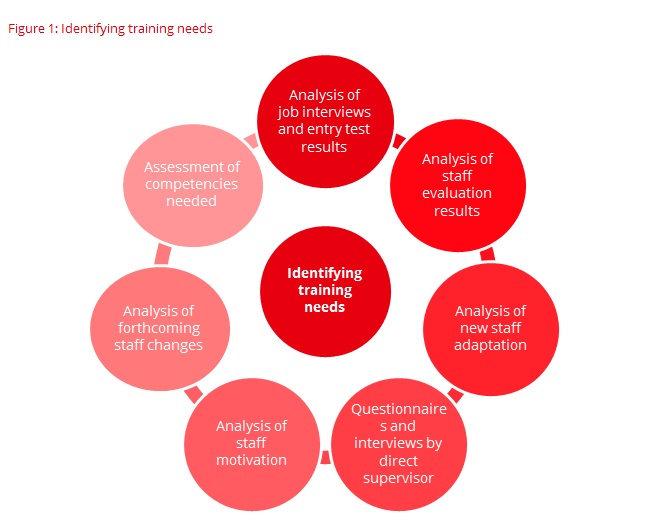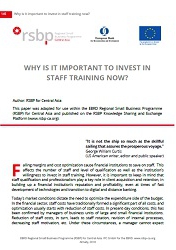“It is not the ship so much as the skillful sailing that assures the prosperous voyage.”
George William Curtis
(US American writer, editor and public speaker)
WHY IS IT IMPORTANT TO INVEST IN STAFF TRAINING NOW?
Falling margins and cost optimization cause financial institutions to save on staff. This affects the number of staff and level of qualification as well as the institution’s willingness to invest in staff training. However, it is important to keep in mind that staff qualification and professionalism play a key role in client acquisition and retention, in building up a financial institution’s reputation and profitability, even at times of fast development of technologies and transition to digital and distance banking.
Today's market conditions dictate the need to optimize the expenditure side of the budget. In the financial sector, staff costs have traditionally formed a significant part of all costs, and optimization usually starts with reduction of staff costs. In present-day conditions, this has been confirmed by managers of business units of large and small financial institutions. Reduction of staff costs, in turn, leads to staff rotation, revision of internal processes, decreasing staff motivation, etc. Under these circumstances, a manager cannot expect employees to adapt to the changing environment without external support. Even under stable market conditions, in order to achieve its goals and implement its development strategy, a financial institution needs to have (1) intelligent staff selection, i.e. a selection process which ensures choosing individuals with appropriate skills, character traits and qualifications for the respective job, and (2) ongoing staff training which is based on the actual training needs of respective staff and the needs of the institution.
In the short term, staff cost reduction can lead to overall cost reduction and cost optimization. At the same time, it is quite possible that expected increase in income will not occur in the medium and long term. The reason may rest precisely in the fact that staff competence, a key to success in any business, is insufficient.
A key point in optimizing training processes and costs is for the financial institution to ensure that staff qualifications and skills are sufficient to meet the institution’s business results.
As an example, we would like to refer to the experience of a large financial institution, which decided to abandon staff training in the short term in order to reduce its costs:
“Already after 6 months of absence of any training at the business unit, the institution observed an obvious decline in employee performance as well as a drastic decrease in the number of clients - old and new. There was also a decrease in the efficiency of business processes and internal communication processes (as a consequence - an increase in the time needed for serving one client, for project approval), as well as a lower level of motivation of key employees, resulting in a further decline of business profitability.”
As this example shows, ill-considered optimization can translate into big losses in the future.
What is the main goal of training?
The goal of training is to provide support to, and improve the efficiency of, staff and with its help – raise the profitability of the financial institution. During times of economic downturn, some financial institutions forget about this and prefer to minimize training costs. It should be pointed out that training should be effective. An appropriate way to reduce training costs is to determine the right, economically sound and effective approach to training. First, it is necessary to understand what exactly you want to teach an employee, and only then select an implementing partner. This means that we should first decide on the target and only then choose the path that will lead us to the intended goal.
Based on the above, we can say the process of choosing the right training topics is of crucial importance. Your choice should be based on actual training needs. Such needs can be of a qualitative nature (what to teach? which skills to develop?), and of a quantitative nature (how many employees and in what departments need to be trained?).

Qualitative training needs can be identified by way of comparing existing staff knowledge and skills against those required for quality job performance. Based on identification of qualitative training needs as shown in Fig. 1 above, you can find out the following:
- the gap between existing and required staff qualification;
- the opinion of all staff of the institution about their individual training needs;
- the ability and desire of each individual staff member to receive training and grow professionally;
- the degree of motivation for development and learning within the institution;
- the training topics that are needed by staff;
- a lot more regarding staff training and development.
The above changes associated with optimizing staff numbers, horizontal and vertical career movements as well as other structural and optimization-related changes will allow you to prepare a comprehensive training plan for a month, a quarter, a year, or even a longer period.
Quantitative training needs can be identified if you know and can correctly assess your financial institution’s economic situation and business environment, its business processes and goals, as well as development plans and then comparing all of this to the quality training needs of each individual employee identified as a result of the analysis (evaluation results, scores, testing results, questionnaires, other).
This will form a basis for an effective solution regarding the target groups of training: how much and what training is needed. This will allow you to optimize the training process and its budget, while ensuring the necessary quality of staff. This is assuming that new staff members have been selected that meet corresponding job requirements and have the personal characteristics, qualities and qualifications needed.
When planning and organizing training, it is important to categorize employees and then determine the appropriate approach to each category based on their level of competence as well as the organizational structure of the financial institution and the specifics of its business processes.
Sometimes you can hear statements such as "Experienced employees do not need any training, they already know everything!" However, it should be pointed out that it is exactly employees of this type that often are the fastest learners. In addition, training can provide additional motivation for these employees who can become multipliers, train other (newly recruited or less experienced) staff and push business forward.
Under present conditions, where the struggle for each client is becoming visible, each leader must find the right way to improve the qualification level of staff since the price of errors of incompetent employees can be too high for business.
Training topics are designed to provide an employee (a group of employees) with the skills and knowledge that can be applied in practice immediately after training and developed in the long term. For example, if an institution notices that the number of eligible clients is decreasing, that it is getting increasingly difficult to acquire new eligible clients, then the topic “Client acquisition/Sales” should become a top priority. If a period is marked by an increase in the number of problem loans, then the topic “Dealing with problem loans” deserves primary attention. Whenever preparing a training curriculum or an individual training event, an institution should bear business objectives and goals in mind.
Another aspect to be considered in the process of training and training cost optimization is “Who will be the trainer?” Training can be both internal (on the basis of an in-house corporate training structure) or external.
Obviously, it makes sense to use internal training capacities, if they exist and have the quality and capacity needed for the purposes of training staff in a timely manner and at the quality level aimed for. If not, then financial institutions should look into acquiring such training from an external provider. External providers should be carefully screened and their offers compared with a view of finding the best ‘fit’ in terms of topic, level, price, frequency, etc.
It should also be noted that training providers often offer ‘open training’ as well as ‘closed training’. Whereas closed training would only be open to a selection of participants, open training would be accessible to participants from a variety of different institutions. Frequently, closed trainings would also be organized for a specific financial institution. This has the big advantage that the trainer would adjust respective training to the specifics of the financial institution. The big advantage of attending open training is the variety of its attendants, which allows to compare different approaches, etc.
If you delegate specialists to open trainings, it is important to understand:
- Which company conducts the training?
- Does the topic of the training meet the business needs of your institution and staff?
- Who are the trainers?
- What is the target audience for the training?
- What employees need this training?
Speaking generally and specifically, when it comes to training, financial institutions tend to be ‘penny wise and pound foolish’, which in turn - as was demonstrated above – may have serious adverse effects on business. More specifically, instead of hiring an experienced external trainer, financial institutions tend to instruct their staff to acquire new know-how themselves or they may prefer to hire less costly trainers without any critical selection based on the trainer’s actual qualification and in-depth knowledge of the subject. Thus, from the very beginning, some financial institutions lay the foundation for spreading know-how and knowledge of lower quality, which again leaves these institutions with undertrained or poorly trained employees.
Therefore, we would like to emphasize the importance of carefully selecting training providers and of choosing providers who will add value by improving staff skills, staff know-how and expertise, and, ideally, support institutions in growing their own knowledgeable multipliers who would become professional in-house trainers after successfully completing appropriate training.
Especially large institutions may maintain very strong own training centers, which can cover nearly all topics that may be needed. However, especially for smaller institutions, it usually makes sense to combine internal and external training. In this way, the scope of topics that can be meaningfully addressed increases significantly.
And finally - a quote from the sequel of Alice’s Adventures in Wonderland:
“Now, here, you see, it takes all the running you can do, to keep in the same place. If you want to get somewhere else, you must run at least twice as fast as that!”
Lewis Carroll, Through the Looking Glass



